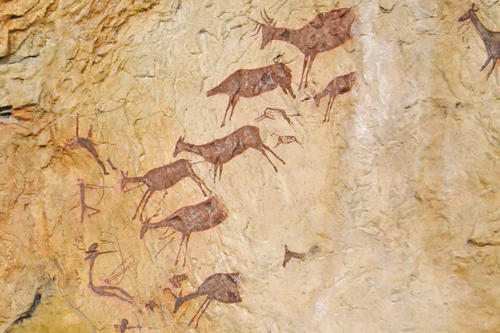Taking Our Forebears’ Measurements
Eva Rosenstock studies the connection between nutrition and body size in prehistoric humans.
Sep 06, 2018
A depiction of a deer hunt in the postglacial period in Cueva de los Caballos, a cave in Spain. Researchers have shown there that body height decreased significantly between approximately 10,000 and 5,000 B.C.
Image Credit: Wikimedia, Joanbanjo / CC BY-SA 3.0
Archaeologist Eva Rosenstock is shown holding a prehistoric femur.
Image Credit: Bernd Wannenmacher
Many parents use a spot on the wall or in a door frame to track how quickly their children grow. If our forebears in the Stone Age had made horizontal marks on walls like modern people do, Eva Rosenstock’s research would be a bit easier.
Rosenstock, an archaeologist at Freie Universität Berlin, has studied how tall prehistoric humans were and what factors might have led to fluctuations in average height.
Humans grow until they are about 20 years old. At that point, the growth plates at either end of the bones close. The maximum height a given individual can reach was probably determined by that person’s genes, Rosenstock explains. But some people never grew to the full height that their genetic makeup would have allowed.
For periods that form part of recorded history – eras documented by written sources – it is relatively easy to trace the connections. If children and adolescents are well nourished, with adequate protein, they grow very tall. Growth slows during periods of malnutrition, and the only way to compensate is if better times return before the individual reaches the age of 20 and he or she can grow further to catch up. Because the connection is so straightforward, economic historians look to height as an indicator of prosperity in a society.
Rosenstock’s research project started out with the idea of harnessing this method for archaeology as well. “I wanted to investigate the connection between prosperity and physical size at a time for which we do not yet have any indicators of how successful certain economic strategies were – namely prehistory.”
In 2011, Rosenstock and her Emmy Noether Junior Research Group “LiVES,” which is financed by the German Research Foundation (DFG), started collecting and studying about 5,000 data sets on prehistoric skeletons from two near-forgotten registers, one in Mainz and one in Geneva, along with newly collected data from the archaeological literature.
The records span from 10,000 to about 1,000 B.C. These were the bones of people from the Stone Age and Bronze Age, including hunter-gatherers and settled farmers and livestock breeders from Europe and the Near East. Thighbones were the most important source of information, Rosenstock explains: “The femur is a sturdy bone. It is often well preserved, and in people, it also accounts for a relatively large share of height.”
But extrapolating a living individual’s full height from the length of one bone requires complicated formulas. Things get even trickier when researchers try to trace trends for periods and areas where not found many bone or arm bones have been found. With that in mind, Marcus Gross, a statistician who works on Rosenstock’s team, programmed algorithms to calculate our forebears’ most likely heights.
To compare bone length and possible living circumstances from different places and eras as well, doctoral candidates Alisa Scheibner and Alisa Hujic additionally analyzed data on carbon and nitrogen isotopes found in bones and teeth. The results opened up a window on the prehistoric diet, offering insight into things like whether the food consumed in a particular region came primarily from plants or animals, and whether it was derived from water or land.
What Rosenstock and her team have spent the last seven years doing represents a new form of archaeology: They have reviewed databases, filled in gaps, and fed data into computers, running computations, then double-checking and running them again. In the end, they gleaned new insights from the past. And those insights contradicted their initial hypothesis.
“It would have been nice if a person’s height had been a useful indicator of prosperity in prehistory as well,” Rosenstock says. “But the correlation between nutrition and height is quite modest.”
For a long time, for example, scientists assumed that the “Neolithic Revolution” had a negative effect on height: When the first humans settled in a single place and adopted agriculture, a diet low in protein became the norm.
But the calculations performed by Rosenstock’s research group suggest something else: “If you compare skeletons from the regions where the new type of economy arose and those to which it spread, average heights in the Near East stay the same, while people get shorter in the Balkans, there is no change in Central Europe, and in Northern Europe people actually grow taller.”
To explain these differences, the researchers had to look to other factors, such as genes. Rosenstock says that when the research group held its final meeting, this past April, there were already signs that their results were a good fit for the research being done by other teams working with archaeogenetic methods, for example.
As for Rosenstock herself, she has emerged from her seven-year project with a positive feeling. “The data we have show that prehistoric people probably didn’t suffer from constant lack of protein as children and adolescents. Most people in the prehistoric era did not experience impaired growth.”
Further Information
Dr. Eva Rosenstock, Freie Universität Berlin, Institute of Prehistoric Archaeology, Tel.: +49 30 838 574 24, Email: rsnstck@zedat.fu-berlin.de


